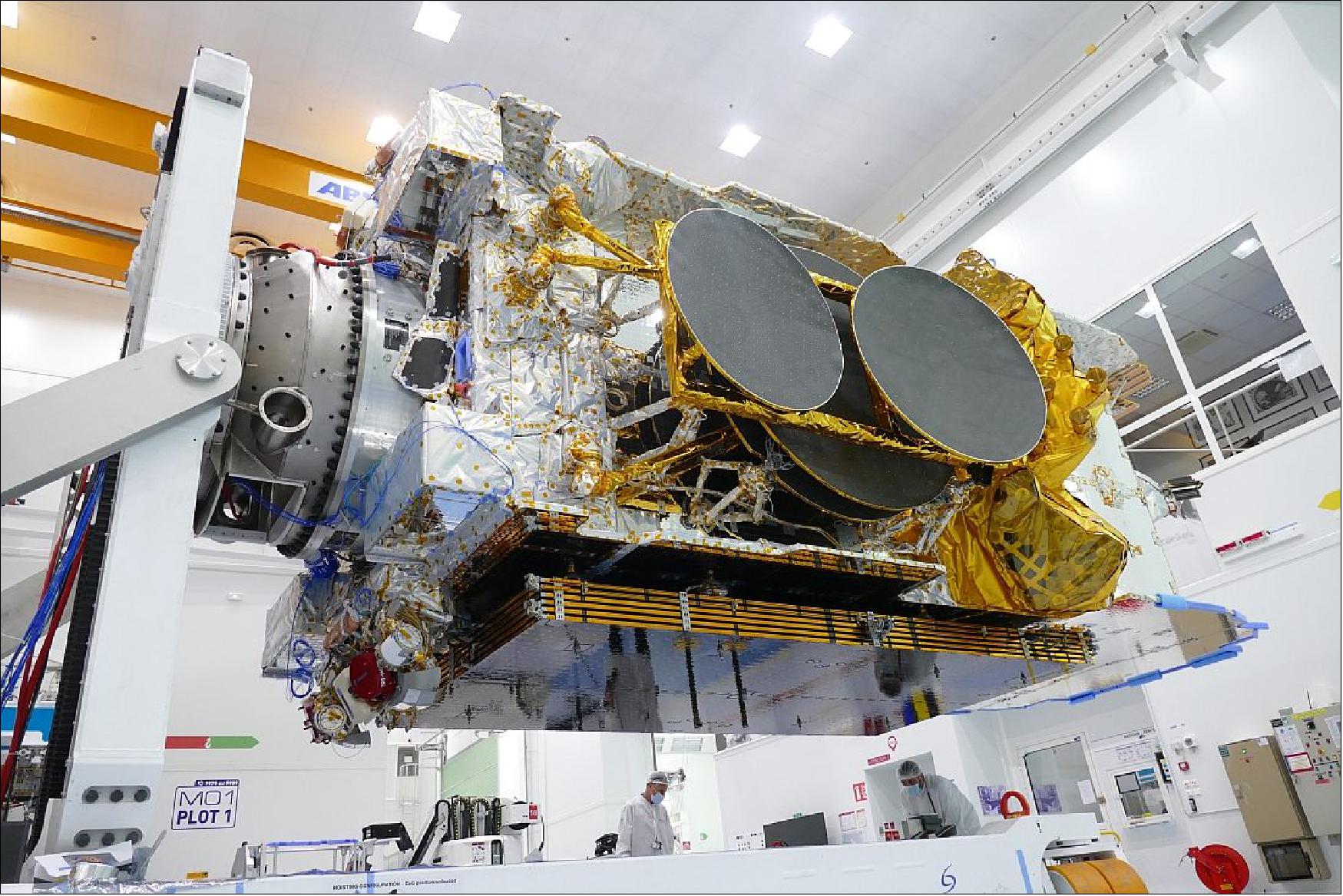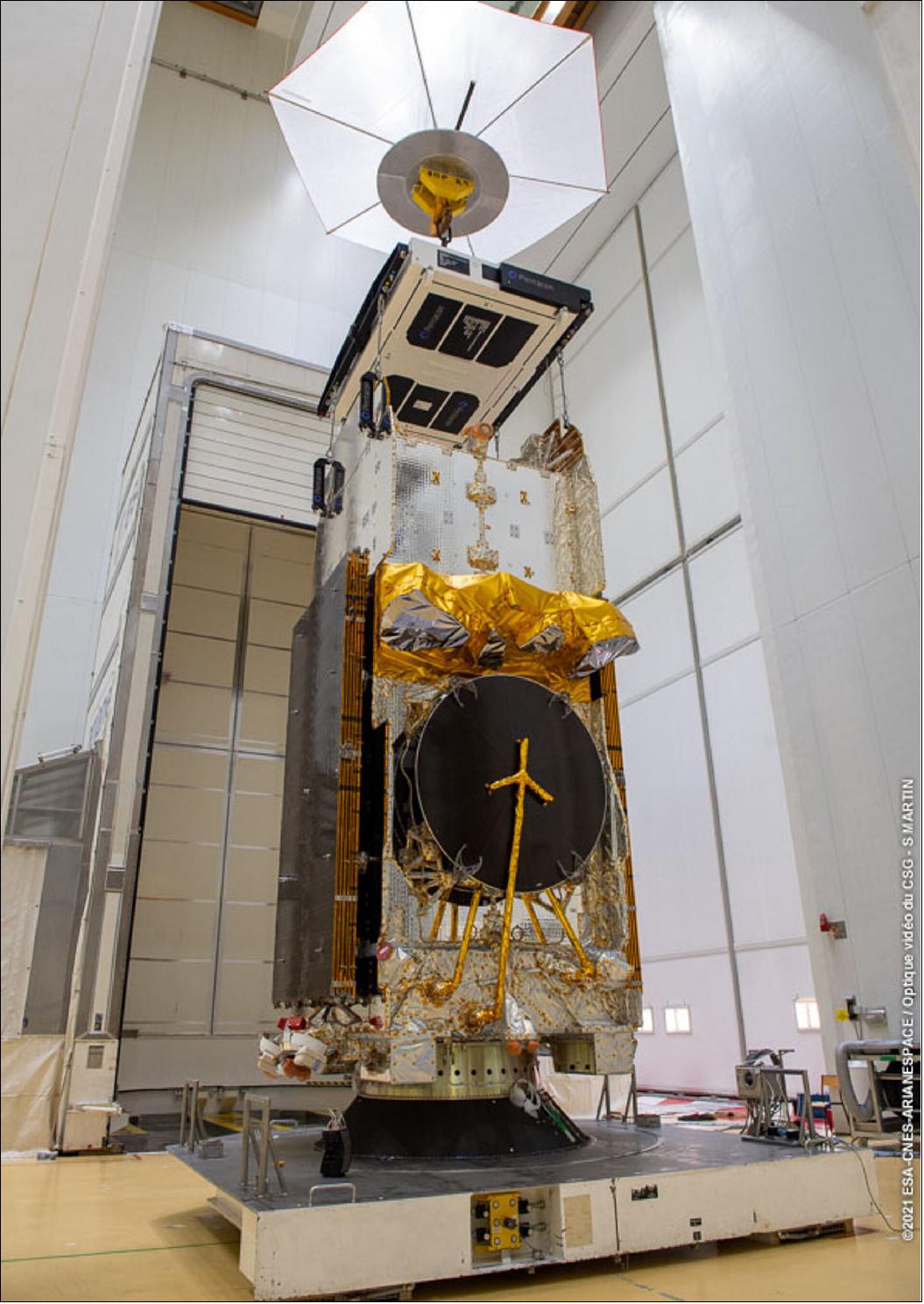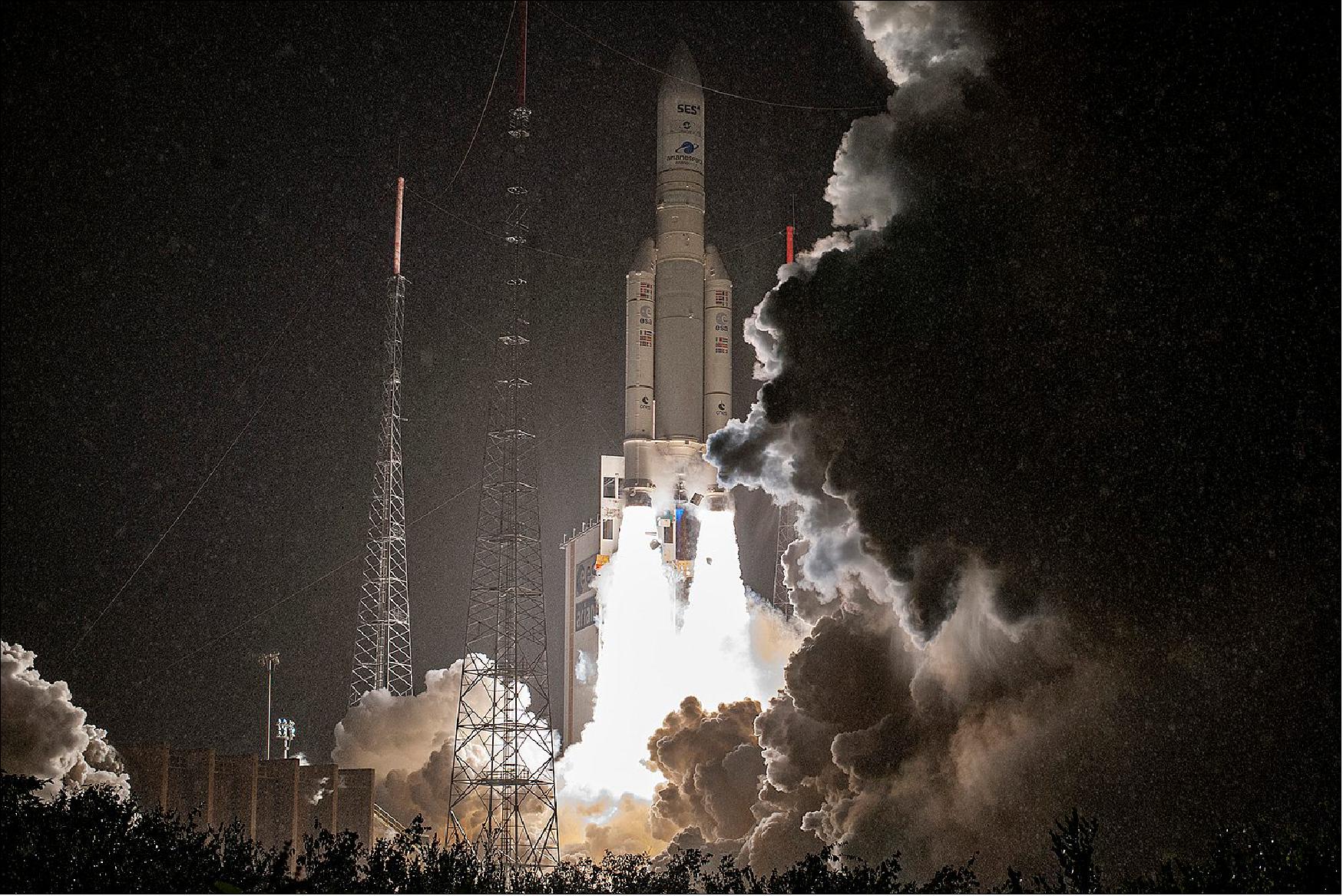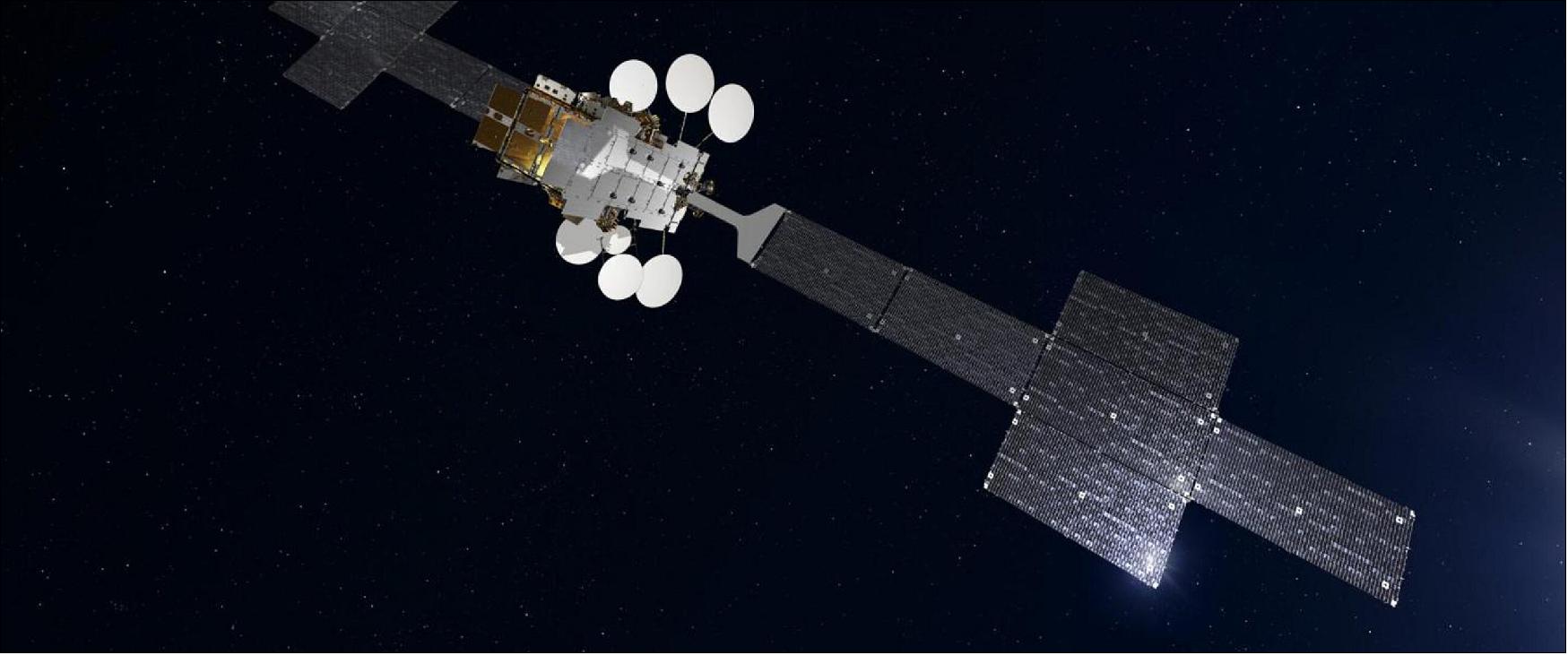SES-17 (Société Européenne des Satellites - 17)
Non-EO
ESA
CNES
Communications
Quick facts
Overview
| Mission type | Non-EO |
| Agency | ESA, CNES |
| Launch date | 24 Oct 2021 |
SES-17 Communication Satellite
Spacecraft Launch References
The SES-17 communication satellite is the new flagship of the SES (Société Européenne des Satellites) fleet of Luxembourg. It is a high throughput geostationary communications satellite designed to enable SES customers to experience endless high-speed connectivity as well as a high degree of flexibility no matter where they operate: on land, at sea, or in the air. Its coverage zone will span North, South and Central America, the Caribbean and the Atlantic Ocean. 1)
The satellite incorporates cutting-edge technologies and is set to deliver the best connectivity experience for customers operating in the aeronautical, maritime, enterprise, and government markets.
SES-17 is a Ka-band High Throughput System (HTS) Geostationary Earth Orbit (GEO) satellite and the first of its kind. SES-17 has been engineered to give our customers, high-speed broadband AND more flexibility, wherever they are located: at sea, in the air or on land.
Development Status
• September 23, 2021: SES-17 telecommunications satellite left Thales Alenia Space’s clean rooms of Cannes on September 22nd, and has just reached Europe’s spaceport, in French Guiana. The satellite is scheduled for launch on October 22nd, where it will be orbited by Arianespace jointly with another Thales Alenia Space-built satellite: Syracuse 4A. 2)

• In September 2019, SES announced it had partnered with satellite payload and network management systems developer, Kythera Space Solutions to develop the ARC (Adaptive Resource Control) software to enable the dynamic control and optimization of power, throughput, beams and frequency allocation on SES-17 and other future high-throughput satellites and their networks. 3)
- In a nutshell, ARC manages dynamic changes in real-time and orchestrates the ground and space resources, from the satellite payload to the gateways and user terminals. The ARC software required years of innovation, needing to balance the intelligence and responsiveness to react to countless situations in space or on the ground, but also the flexibility to work with all of SES’s next-gen satellites in GEO and MEO and ground hardware infrastructure.
• On 12 September 2016, SES S.A. ordered the SES-17 dedicated Ka-band high-throughput satellite from Thales Alenia Space of France and Italy, the main contractor for SES's O3b satellites. SES has simultaneously entered into a long-term commercial agreement with Thales to offer FlytLIVE, a new inflight connectivity service over the Americas and the Atlantic Ocean region. SES will operate the satellite infrastructure for FlytLIVE, as well as the complementary ground network. 4)
- With the procurement of SES-17, SES has simultaneously entered into a separate commercial agreement with Thales, a leader in inflight entertainment and connectivity for airline passengers over the Americas. As SES-17’s first large anchor customer, Thales will be using the satellite’s next generation high throughput coverage to provide FlytLIVE, a new and next-generation connectivity solution for airlines, with full Internet services, including video streaming, games, social media and live television to passengers traveling over North America, South America, the Caribbean, Mexico, and the Atlantic Ocean. Thales will launch FlytLIVE in 2017, operating it prior to the launch of SES-17 in 2020 on two existing Ka-band multi-beam satellites from SES.
Spacecraft
SES-17 is based on the three axis stabilized Spacebus NEO satellite bus. It has a launch mass of 6,411 kg (dry mass of 5,060 kg) and produces 15 kW of power. Like all Spacebus NEO, SES-17 will use electric propulsion exclusively for both orbit raising and station keeping.
Built by Thales Alenia Space, SES-17 marks an important milestone in satellite technology as the first Ka-band geostationary satellite to embark a fully digital payload powered the most powerful digital transparent processor (DTP) ever placed in orbit. It will have nearly 200 user beams that can be connected to any other beam at any time. This, combined with the ability to dynamically change the power and frequency allocation of any beam, means that SES-17 can adapt to changing customer needs in real-time.
It is also the first GEO satellite to use Adaptive Resource Control (ARC), an industry-first software system that leverages the full flexibility of totally digital payloads to autonomously adapt space and ground resources on the fly to meet customer needs.
The satellite features a new very powerful on-board processor to manage high-speed data traffic in a flexible and efficient way. It belongs to a new generation of data intensive high-throughput or very-high-throughput satellites and uses a fifth-generation digital transparent processor for more capacity and flexibility.
SES-17 also features an innovative cooling system jointly developed under the ESA Spacebus NEO Partnership Project with the French Space Agency, CNES, and satellite manufacturer Thales Alenia Space, and used for the first time on a large commercial telecommunications satellite. The cooling system is the first mechanically pumped loop to be used on large commercial telecommunications satellites. It was designed to be robust to endure the demanding launch environment and to then operate perfectly, without maintenance, for more than 15 years. To maintain acceptable equipment temperature limits, the payload needs to be actively cooled by moving the heat away and dissipating it into cold space.
ESA’s Neosat program comprises both Spacebus Neo by Thales Alenia Space and Eurostar Neo by Airbus. It includes development up to in-orbit validation of new satellite product lines for both companies, allowing the European space industry to deliver competitive satellites for the global commercial satellite market. — To date, 15 Neosat satellites have been sold by European industry to six satellite operators, generating exceptional return on investment to industry and participating states.
Elodie Viau, ESA’s Director of Telecommunications and Integrated Applications, said: “I am proud to witness the successful launch of SES-17 and Syracuse 4, which serves as a show-case for how ESA is pushing the boundaries of technology, supporting the European space industry on the world market and introducing innovative services for European citizens.
“ESA fosters innovation in the European space industry, enabling it to succeed in the highly competitive, fast evolving global telecommunications markets. Investing in space creates jobs and prosperity on Earth. I congratulate all the teams from our private partners and from ESA for their collaboration leading to this success.”

Launch
The satellites SES-17 of SES S.A. and Syracuse 4A, a French military communication satellite of DGA (Armament General Directorate), both manufactured by Thales Alenia Space, were launched on 24 October 2021 at 02:10 UTC on an Ariane 5 ECA vehicle of Arianespace from Launch Complex ELA-3 in Kourou. 5) 6)
For its 111th launch, Ariane 5 executed the highest performing flight by any launcher to geostationary transfer orbit (GTO): with two payloads on board, SES-17 and SYRACUSE 4A, with a total mass of 10,264 kg (6,411 kg for SES-17 and 3853 kg for SYRACUSE 4A), Ariane 5 achieves a world record for injection into this orbit. This launch also included a 1.5 m extension placed under the long fairing in order to adapt it to the specific needs of its two passengers.
“With this new success for Ariane 5, which comes a week after its previous launch, Arianespace is delighted to serve the interests of two loyal customers, the operator SES and the French Ministry of the Armed Forces”, declared Stéphane Israël, Chief Executive Officer of Arianespace. “VA255, by putting two highly innovative satellites manufactured by Thales Alenia Space into orbit, demonstrates once again the competitiveness and reliability of our launch solutions serving the ambitions of our private and institutional clients. Dedicated to connectivity and security, these satellites are at the core of our mission: Space for a better life on Earth. The next challenge for Ariane 5 will be the launch of NASA’s space telescope, James Webb, in partnership with the European Space Agency. Mission to Success!”

Orbit: Once the SES-17 satellite reaches its geostationary orbit in mid-2022 with its all-electric system, it will be positioned into its orbital slot at 67.1º W above the equator (Ref. 6).
When operational, anchor customer Thales InFlyt Experience will use SES-17’s connectivity to power its next-generation aviation connectivity solution, FlytLIVE. Thales InFlyt Experience will ensure both crew and passengers will have an always-on high-speed Wi-Fi connection at peak times and in high-traffic routes while optimizing bandwidth.
“Today’s launch of SES-17 is an exciting milestone for our FlytLIVE Connectivity Solution currently flying within the United States,” said Craig Olson, Vice President at Thales InFlyt Experience. “The network and satellite architecture was specifically developed for the unique connectivity requirements of our commercial aviation customers and their passengers. With SES-17, FlytLIVE will provide full coverage for the entire Americas and North Atlantic Corridor delivering an unmatched connectivity experience in the air.”
“We are immensely excited to have SES-17 join our GEO fleet and medium earth orbit (MEO) constellation. SES-17 is the fruit of a successful collaboration between the Thales Group, Thales Alenia Space and SES, and will enable us to address the exponential connectivity demands in aviation and maritime, and to accelerate digital inclusion initiatives across the Americas,” said Steve Collar, CEO of SES. “Thanks to Arianespace, SES-17 is now on its way to orbit. We are looking forward to SES customers being able to leverage the high throughput, global reach and low-latency of SES’s multi-orbit, interoperable Ka-band satellite network comprising SES-17 and our upcoming O3b mPOWER constellation.”
“What a launch! — SES-17 has mobilized all Thales Alenia Space experts – from the innovative design of the satellite itself to the last combined operations – and is now on its way to orbit. Fully-digital and highly-innovative, SES-17 will benefit from all the state-of-art technologies we have developed to fulfil the market’s connectivity needs,” said Herve Derrey CEO of Thales Alenia Space.
Mission Status
• July 22, 2022: A large data-driven telecommunications satellite that uses innovative technology to keep cool as well as other innovations – developed under an ESA Partnership Project – has started its commercial service. 7)

- The very high throughput SES-17 belongs to a new generation of data intensive satellites and, with its new fifth-generation digital transparent processor, is able to deliver up to ten times more capacity than traditional satellites with unmatched flexibility and efficiency.
- Processing large volumes of data generates heat within the spacecraft that must be dissipated for the satellite to continue long-lasting and reliable operations. Engineering teams under the ESA Neosat Partnership Project with satellite manufacturer Thales Alenia Space developed an innovative thermal cooling system – the two-phase mechanically pumped loop – that is able to circulate fluid refrigerant to remove heat. It is a first of its kind to be featured on a large commercial telecommunications satellite.
- ESA Partnership Projects help to develop sustainable end-to-end systems up to in-orbit validation.
- ESA’s Neosat programme comprises both Spacebus Neo by Thales Alenia Space and Eurostar Neo by Airbus and is managed jointly by ESA and the French Space Agency CNES. It includes development up to in-orbit validation of new satellite product lines for both companies, allowing the European space industry to deliver competitive satellites for the global commercial satellite market.
- Some 16 Neosat satellites have now been sold by European companies, and the programme is predicted to generate more than 20 times the return on investment to its 12 participating states and their space companies, according to an independent analysis by Euroconsult.
References
1) ”SES-17: Experience Endless Connectivity,” SES, URL: https://www.ses.com/news/ses-17-experience-endless-connectivity
2) ”SES-17 satellite has arrived in French Guyana,” Thales Group, 23 September 2021, URL: https://www.thalesgroup.com/en/worldwide/space/news/ses-17-satellite-has-arrived-french-guyana
3) ”SES to Enhance and Expand O3b mPOWER System Capabilities with Dynamic Software Innovation,” SES Press Release, 5 September 2019, URL: https://www.ses.com/press-release/ses-enhance-and-expand-o3b-mpower-system-capabilities-dynamic-software-innovation
4) SES orders high throughput satellite from Thales with first secured anchor customer for inflight connectivity,” SES Press Release, 12 September 2016, URL: https://www.ses.com/press-release/ses-orders-high-throughput-satellite-thales-first-secured-anchor-customer-inflight
5) ”Operated by Arianespace for the benefit of SES and the French Ministry of the Armed Forces; Ariane 5 VA255 flight is the highest performing ever launched to geostationary transfer orbit,” Arianespace Press Release, 24 October 2021, URL: https://www.arianespace.com/press-release/va255-ariane-5-success/
6) ”SES-17 Successfully Launched on Ariane 5,” SES Press Release, 24 October 2021, URL: https://www.ses.com/press-release/ses-17-successfully-launched-ariane-5
7) ”Innovative data satellite enters commercial service,” ESA Applications, 22 July 2022, URL: https://www.esa.int/Applications/Telecommunications_Integrated_Applications/Innovative_data_satellite_enters_commercial_service
The information compiled and edited in this article was provided by Herbert J. Kramer from his documentation of: ”Observation of the Earth and Its Environment: Survey of Missions and Sensors” (Springer Verlag) as well as many other sources after the publication of the 4th edition in 2002.
Spacecraft Launch References Back to top